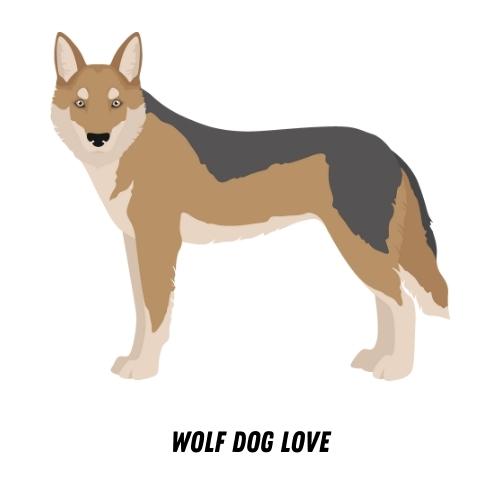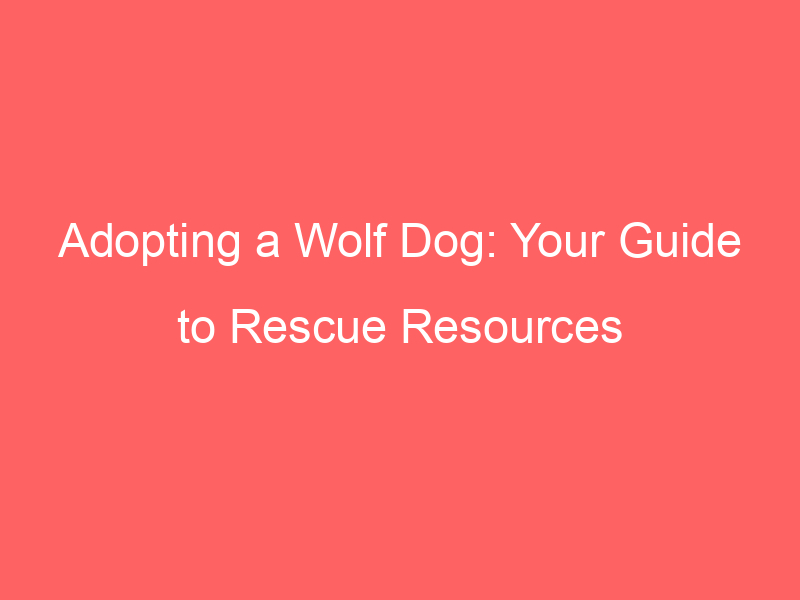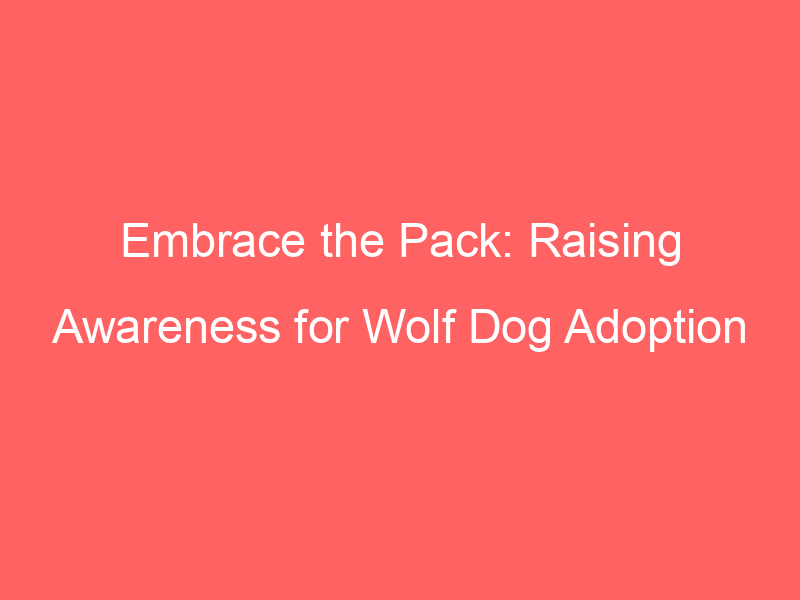Introduction to Wolf Dog Adoption
Adopting a pet is a significant decision. When the pet in question is a Wolf Dog, the decision becomes even more critical. This guide will help you understand what a Wolf Dog is, why you might consider adopting one, and common misconceptions about these unique animals.
- Understanding what a Wolf Dog is
- Why consider Adopting a Wolf Dog
- Common misconceptions about Wolf Dogs
A Wolf Dog, also known as a Wolf Hybrid, is a crossbreed between a domestic dog and a wild wolf. They are known for their striking appearance, which often resembles that of a wolf, and their unique behaviors that are a blend of both wolf and dog traits. They are intelligent, loyal, and require a lot of physical and mental stimulation.
Wolf Dogs are not for everyone, but they can make wonderful pets for the right person. They are incredibly loyal, intelligent, and active. They require a lot of exercise and mental stimulation, which can be a great fit for active individuals or families. Wolf Dogs are also known for their unique appearance and behaviors, which can be a source of joy and fascination for their owners.
There are many misconceptions about Wolf Dogs. Some people believe they are dangerous or untrainable, but this is not the case. Wolf Dogs can be trained and socialized just like any other dog, and they are not inherently dangerous. However, they do require a lot of time, patience, and understanding due to their unique needs and behaviors. It’s also important to remember that not all Wolf Dogs are the same – their behaviors and needs can vary greatly depending on their specific breed and individual personality.
In the following sections, we will delve deeper into the process of adopting a Wolf Dog, including preparation, finding a reputable rescue organization, and what to expect after adoption. Stay tuned to learn more about this unique and rewarding journey.
Preparation for Wolf Dog Adoption
Adopting a Wolf Dog is a significant commitment that requires careful preparation. Here are some steps to help you understand the adoption process and prepare for your new furry friend.
Understanding the Wolf Dog Adoption Process
Adopting a Wolf Dog is not like adopting a regular dog. It requires a deeper understanding and commitment. Here are some steps you can take:
- Research about Wolf Dogs
- Find a reputable Wolf Dog Rescue Organization
- Prepare your home for a Wolf Dog
Before you decide to adopt a Wolf Dog, it’s crucial to understand what you’re getting into. Wolf Dogs are a unique breed that requires special care and attention. They are a mix of a domestic dog and a wild wolf, which makes them more challenging to handle than regular dogs. They need a lot of exercise, a special diet, and a large, secure outdoor space. They can also be more aggressive and less predictable than regular dogs. Therefore, it’s essential to do your research and make sure you’re prepared for the responsibility.
Once you’ve done your research and decided that a Wolf Dog is the right pet for you, the next step is to find a reputable Wolf Dog rescue organization. These organizations are dedicated to rescuing and rehoming Wolf Dogs, and they can provide you with valuable information and support. They can also help you find a Wolf Dog that is a good match for you and your lifestyle.
Preparing your home for a Wolf Dog is another essential step in the adoption process. Wolf Dogs need a lot of space to run and play, so you’ll need a large, secure yard. You’ll also need to make sure your home is safe and comfortable for your new pet. This might involve getting a large dog bed, installing a secure fence, and making sure there are no hazardous substances or objects that your Wolf Dog could get into.
Remember, adopting a Wolf Dog is a big responsibility, but with the right preparation and commitment, it can be a rewarding experience.
Resources for Wolf Dog Adoption
Adopting a wolf dog is a big decision and it’s important to be well-prepared. Here are some resources that can help you understand wolf dogs better and guide you through the adoption process.
-
Books and Online Resources about Wolf Dogs
Books are a great way to start learning about wolf dogs. Some recommended titles include “Living with Wolfdogs” by Nicole Wilde and “The Wolf Hybrid” by Dorothy Prendergast. These books provide valuable insights into the behavior, training, and care of wolf dogs.
Online resources can also be very helpful. Websites like the International Wolf Center and the Wolf Dog Education Network offer a wealth of information on wolf dog breeds, their characteristics, and their needs.
-
Wolf Dog Adoption Resources
There are several organizations dedicated to wolf dog adoption. These include the National Wolfdog Alliance and the Wolfdog Rescue Resources. They provide information on available wolf dogs for adoption, the adoption process, and post-adoption support.
It’s also a good idea to connect with local animal shelters and rescue groups. They can provide information on wolf dogs in your area that need a home.
-
Connect with Wolf Dog Rescues
Wolf dog rescues are a valuable resource for anyone considering adopting a wolf dog. They can provide firsthand information on the challenges and rewards of living with a wolf dog. They can also help match you with a wolf dog that fits your lifestyle and experience level.
Some well-known wolf dog rescues include the Wolf Dog Rescue Foundation and the Wolf Sanctuary. Reach out to them for advice, support, and to learn about wolf dogs currently looking for a new home.
Remember, adopting a wolf dog is a long-term commitment. It’s important to do your homework and be fully prepared. These resources can help you make an informed decision and provide a loving and suitable home for your new wolf dog.
Wolf Dog Rescue Organizations
When you decide to adopt a wolf dog, it’s important to find a reputable rescue organization. These organizations are dedicated to the care and protection of wolf dogs, and they can help you find the perfect furry friend to join your family. Here’s how to choose a wolf dog rescue organization:
How to Choose a Wolf Dog Rescue Organization
- Check the reputation of the organization:
Before you decide on a rescue organization, do some research. Look for reviews or testimonials from people who have adopted from them before. A good reputation means the organization is likely to provide healthy, well-cared-for animals and support you through the adoption process.
- Ask about their adoption process:
Each rescue organization will have its own process for adoption. Some may require home visits, interviews, or references. Others may have a more straightforward process. It’s important to understand what you’re getting into before you start the process.
- Visit the organization and meet the Wolf Dogs:
Finally, it’s always a good idea to visit the organization in person. This allows you to meet the wolf dogs, see the conditions they’re kept in, and get a feel for the organization. Remember, you’re not just adopting a pet – you’re also entering into a relationship with the rescue organization.
Choosing a wolf dog rescue organization is a big decision, but with a little research and preparation, you can find the perfect match for you and your future pet.
List of Reputable Wolf Dog Rescue Centers
When it comes to adopting a wolf dog, it’s important to find a reputable rescue center. These organizations are dedicated to the care and protection of these unique animals. They ensure that each wolf dog is healthy, well-cared for, and ready for a new home. Here are three highly regarded wolf dog rescue centers:
- Wolf Haven International: Located in Tenino, Washington, Wolf Haven International has been rescuing and providing sanctuary for displaced, captive-born wolves for over 35 years. They are committed to improving the quality of life for all wolves by providing a safe and nurturing environment.
- Wild Spirit Wolf Sanctuary: This rescue center in New Mexico is dedicated to rescuing displaced, unwanted, and un-releasable captive-bred wolves, wolf dogs, and other related species. They provide lifetime care and enrichment for these animals, promoting education about these species, their needs and the challenges they face.
- Wolf Mountain Sanctuary: Based in Lucerne Valley, California, Wolf Mountain Sanctuary is a non-profit, educational organization dedicated to the preservation, protection, and proper management of wolves in the wild and in captivity. They offer a safe haven for wolf dogs that have been abused, neglected, or abandoned.
Remember, adopting a wolf dog is a big responsibility. It’s important to do your research and choose a reputable rescue center that can provide the support and guidance you need throughout the adoption process.
Adopting a Wolf Dog: The Process
Adopting a wolf dog is a unique and rewarding experience. However, it’s not a decision to be taken lightly. It requires careful planning, preparation, and commitment. Here, we will guide you through the initial steps of the adoption process.
Initial Steps to Adopt a Wolf Dog
Adopting a wolf dog involves a few key steps. These steps are designed to ensure that both you and the wolf dog will be a good match for each other. Let’s take a closer look at these steps.
- Fill out an Adoption Application
- Home Visit and Interview
- Meet the Wolf Dogs
The first step in adopting a wolf dog is to fill out an adoption application. This application will ask you about your living situation, your experience with dogs, and your expectations for your future pet. It’s important to be honest and thorough in your answers. The information you provide will help the rescue organization determine if a wolf dog is a good fit for you.
After you’ve filled out your application, a representative from the rescue organization will visit your home. This visit is to ensure that your home is a safe and suitable environment for a wolf dog. They may check for things like a secure fence, adequate space, and absence of small pets that a wolf dog might see as prey. During this visit, you’ll also have an interview where you can ask questions and discuss any concerns you may have.
The final step in the initial process is to meet the wolf dogs. This is an exciting time! You’ll have the opportunity to interact with the dogs and see which one you connect with. Remember, each wolf dog has its own unique personality and needs. It’s important to choose a dog that fits well with your lifestyle and personality.
These initial steps are crucial in ensuring a successful adoption. They help to make sure that you are prepared for the unique challenges and rewards that come with owning a wolf dog. In the next section, we will discuss the final steps in the adoption process.
Finalizing the Wolf Dog Adoption
Once you’ve completed the initial steps in the adoption process, you’re ready to finalize your Wolf Dog adoption. This is a significant moment, and it’s important to understand each step clearly.
- Sign the Adoption Contract
- Pay the Adoption Fee
- Bring Your New Wolf Dog Home
First, you’ll need to sign the adoption contract. This is a legal document that outlines your responsibilities as the new owner of the Wolf Dog. It’s crucial to read through this contract carefully and ensure you’re ready to meet all the requirements. Remember, adopting a Wolf Dog is a long-term commitment that requires time, effort, and resources.
Next, you’ll be required to pay the adoption fee. This fee usually covers the cost of veterinary care, food, and shelter that the rescue organization has provided for the Wolf Dog. The exact amount can vary, but it’s typically a small price to pay for the joy of bringing a new family member home.
Finally, the moment you’ve been waiting for – bringing your new Wolf Dog home! This is an exciting time, but it’s also a period of adjustment for both you and your new pet. Make sure to prepare a comfortable space for your Wolf Dog and spend quality time together to build a strong bond.
Finalizing the adoption is just the beginning of your journey with your new Wolf Dog. It’s a rewarding experience that comes with its own set of challenges. But with patience, love, and understanding, you’ll form a bond that lasts a lifetime.
| Finalizing the Adoption: Key Steps |
|---|
| Sign the adoption contract |
| Pay the adoption fee |
| Bring your new Wolf Dog home |
Post-Adoption: Living with a Wolf Dog
Adopting a Wolf Dog is a rewarding experience, but it also comes with its unique set of challenges. This section will provide you with some practical tips to ensure a successful post-adoption experience.
Tips for a Successful Wolf Dog Adoption
Here are some key tips to consider for a successful Wolf Dog adoption:
- Provide proper training and socialization: Wolf Dogs are intelligent and require mental stimulation. Training should start as early as possible. Socialization with other animals and humans is also crucial. This will help your Wolf Dog to be more comfortable in different situations and prevent aggressive behavior.
- Ensure a balanced diet and regular exercise: A balanced diet is vital for your Wolf Dog’s health. They need a diet rich in protein and should avoid foods with artificial additives. Regular exercise is also important as Wolf Dogs are active and need plenty of physical activity to stay healthy and happy.
- Regular vet check-ups: Regular vet visits are essential to monitor your Wolf Dog’s health. Wolf Dogs can be prone to certain health issues, so early detection and treatment can make a significant difference. It’s also important to keep up with vaccinations and flea and tick prevention.
Adopting a Wolf Dog is a big responsibility, but with the right preparation and commitment, it can be a rewarding experience. Remember, the key to a successful adoption is understanding and meeting your Wolf Dog’s unique needs.
Challenges and Rewards of Adopting a Wolf Dog
Adopting a wolf dog can be a rewarding experience, but it’s not without its challenges. Let’s explore a case study and some key takeaways from wolf dog owners to better understand what this journey entails.
- Case study: A successful Wolf Dog adoption story
- Key takeaways from Wolf Dog owners
Meet John and his wolf dog, Shadow. John adopted Shadow from a wolf dog rescue organization three years ago. The journey wasn’t easy. Shadow was initially wary and untrusting, but with patience, love, and consistent training, Shadow became a loving and loyal companion. John emphasizes the importance of understanding a wolf dog’s needs and behaviors. “It’s not like adopting a regular dog,” he says. “You need to respect their wild instincts and give them plenty of space and stimulation.”
Wolf dog owners have shared some crucial insights from their experiences. Here are the key takeaways:
| Takeaway | Explanation |
|---|---|
| Patience is key | Wolf dogs take time to adjust to new environments and trust their owners. Patience and consistency are vital. |
| Training and socialization | Wolf dogs require early and consistent training and socialization to ensure they can interact safely with people and other animals. |
| Space and stimulation | These animals are active and need plenty of physical and mental stimulation. A large, secure outdoor space is ideal. |
| Healthcare | Regular vet check-ups are necessary to ensure the wolf dog’s health and well-being. |
Adopting a wolf dog is a commitment that comes with unique challenges. However, the rewards of companionship, loyalty, and the joy of providing a loving home to these special creatures make the journey worthwhile.








